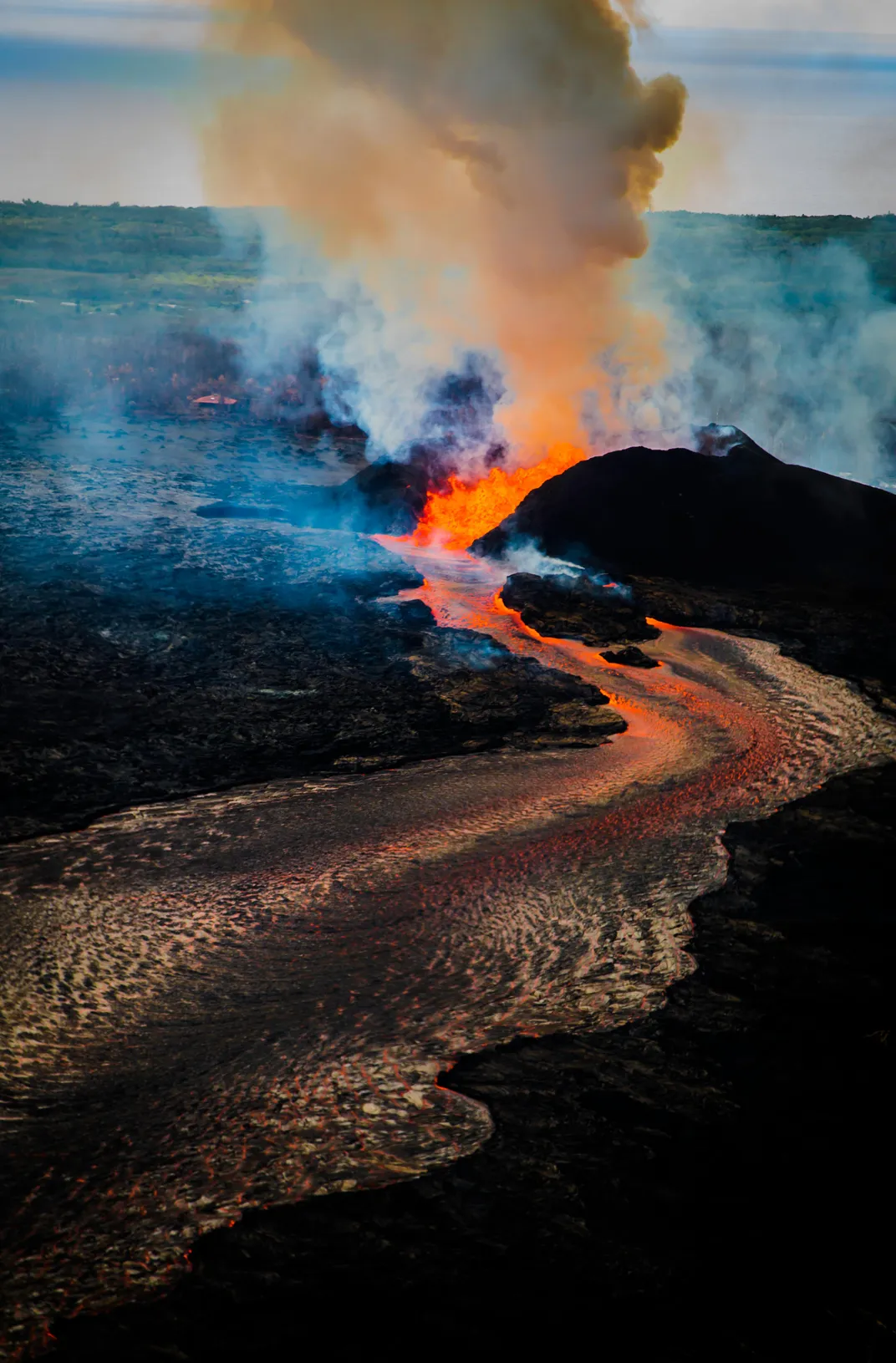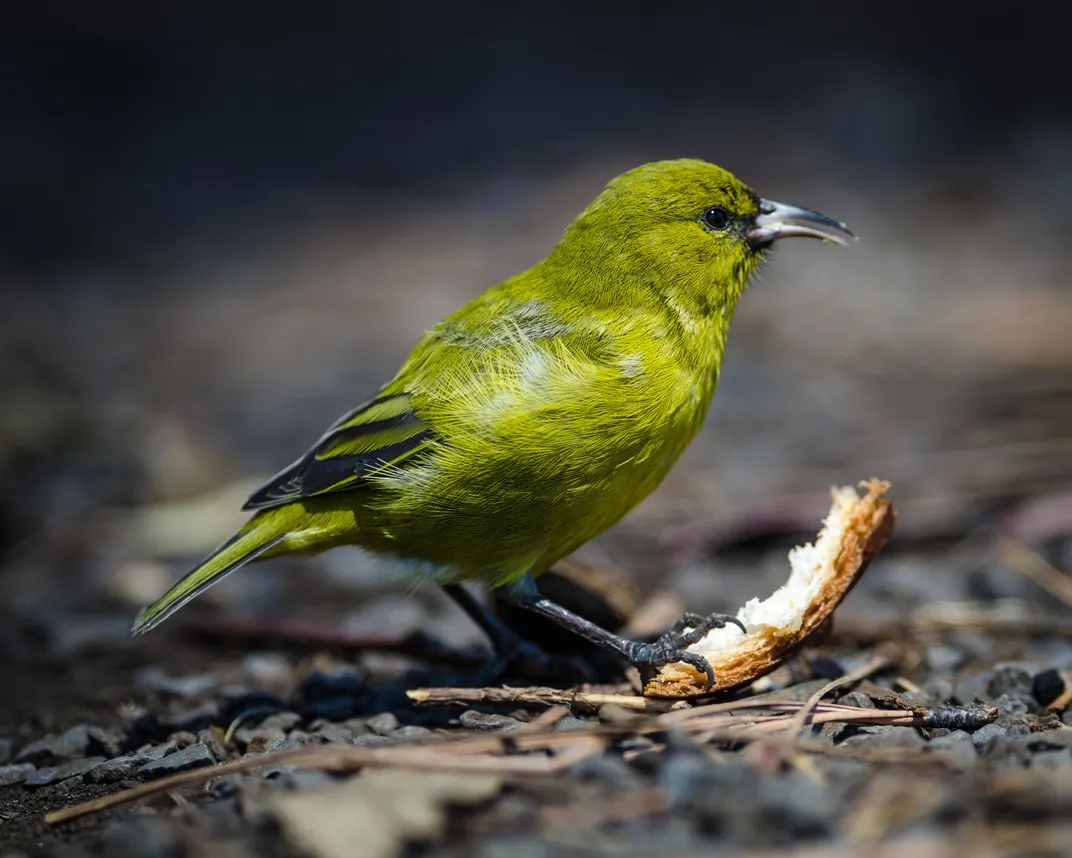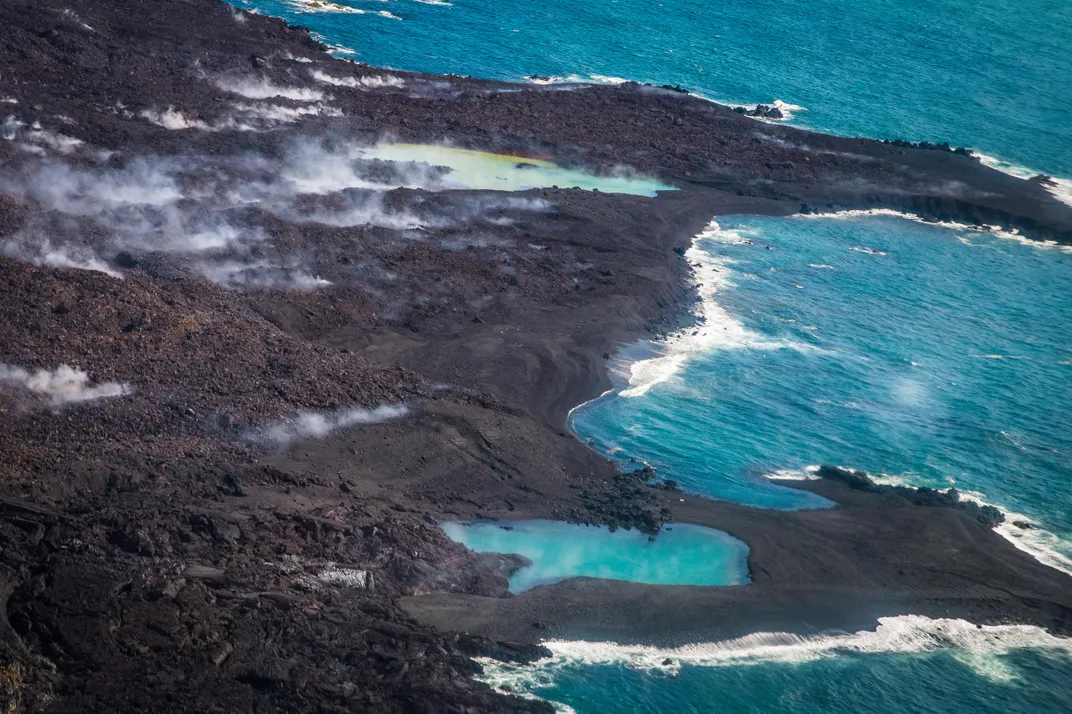How Volcanoes Reshape Ecosystems
Volcanic eruptions change the natural world in dramatic ways
/https://tf-cmsv2-smithsonianmag-media.s3.amazonaws.com/filer/03/27/032787a4-e730-47c3-bd32-62be4a9b6e5d/mackenzie_sra__malama_ki_fr.jpg)
Weighing the equivalent of two nickels and a penny, the Hawai`i `amakihi is a fascinating little green bird. Its multi-purpose tongue is tubular for slurping nectar and fringe-tipped for capturing insects and other arthropods. Its strong claws allow it to forage in almost any position, including upside down. The Hawai`i `amakihi is also known to sleep with its head tucked and one foot raised. But what’s really astonishing scientists is how a sub-population of these birds are surviving in a low-elevation corner of Hawai`i Island where once mosquitoes carrying avian diseases were threatening them with extinction. Unfortunately, these disease-tolerant birds sit directly in the path of the erupting Kīlauea volcano.
“I’ve worked out here for over 40 years. I’ve seen many eruptions, and eruptions are always spectacular,” Jim Jacobi, a biologist with the Pacific Island Ecosystems Research Center, tells Smithsonian.com.
Fascinating volcanologists at Kīlauea is Fissure 8. Fissure 8 started in May as a crack in the ground, just like two dozen others, billowing sulfur dioxide and, at times, jetting lava fountains a couple hundred feet high in the middle of a housing subdivision along the lower eastern side of the gently sloping volcano. Unlike all the other fissures, however, Fissure 8 didn’t fizzle out. Instead, since splitting open, it continued to pump out lava, creating a seething river moving at speeds up to 25 miles per hour in its eight-mile quest for the sea.
“When we went up to Fissure 8,” Jacobi says, “Two things struck me. The human impacts—there was nobody around [due to evacuations]—and secondly the vegetation was just dead.”

Volcanoes around the world are responsible for shaping 80 percent of Earth’s surface. Yet volcanoes are notorious for the destruction they wield. News headlines often focus on the human impacts. In the three months since this new eruption sprouted along the lower East Rift Zone of Kīlauea, approximately 800 homes, part of a geothermal energy plant, and a school have been engulfed. Thousands of people have been evacuated.
But volcanic eruptions also reshape the natural world in dramatic ways.
Stratovolcanoes like Volcán de Fuego in Guatemala, which erupted in June, do so violently, smothering just about everything in range—homes, automobiles, animals and plants alike. In 2008, Kasatochi, a remote volcanic island in the Aleutian chain, rumbled to life for the first time in modern history. The only two humans—biologists—on the small island scrambled aboard a fishing boat an hour before the volcano started spitting out clouds of hot gas and ash that shut down air travel across the North Pacific. In a matter of days, the island, home to a quarter-million seabirds known as auklets, went from lush green to ashy gray. Nest success that year: zero.
Kīlauea’s had its share of explosive eruptions, but in historic times, it’s behaved in what volcanologists call an "effusive" manner, meaning that instead of erupting violently, it oozes slow-moving lava from vents or fissures at various points that follow the ground’s contour downslope. That's what's been happening at the volcano's Fissure 8.
One thing Kīlauea’s natural environment has going for it, according to Jacobi, is that most of the lava's impacts are very localized. Yet Hawai`i is home to more endangered species than anywhere else in the United States, and many of those protected flora and fauna are found in isolated areas.
Kīlauea's landscape is pocked with “kīpukas,” patches of higher-elevation land on which plants have taken root and around which newer lava flows have swirled. Each kīpuka appears as an island of life surrounded by barren seas of hardened lava.
One kīpuka recently impacted by Kīlauea is the 1,514-acre Malama Kī Forest Reserve, prized for its low-elevation stand of native `ohia trees. It’s here the sub-population of Hawai`i `amakihi is eking out a living. Unfortunately, half of the reserve, a mix of native `ohia and introduced trees, has been covered by lava. What vegetation the lava didn’t inundate, volcanic gasses have browned, defoliated and suffocated. Populations of two endangered native plants were lost.
For now, conditions remain too dangerous for scientists to conduct in-depth surveys, so no one really knows how the Hawai`i `amakihi are faring. “Some would have been nesting, and those most certainly would have failed,” Eben Paxton, a research ecologist also with the Pacific Island Ecosystems Research Center, says. He’s part of a team that was awarded a $2.5 million grant from the National Science Foundation to study the Hawai`i `amakihi’s apparent growing resistance to avian malaria. “At a minimum, the vog [volcanic gases] will stress `ohia, maybe inhibiting blooming, and fumigate insects,” Paxton says. “That would be a big reduction in food resources.”
Some birds may have succumbed to volcanic gases. “I would think others would move. But in moving, they’d have to find another place with resources and not too much competition and that may or may not be an easy thing.”
Since the 'amakihi of the forest reserve are a sub-population, Paxton doesn’t fear extinction of the entire species. But if nearby Mauna Loa rumbles to life, he'll worry. At risk on the slopes of this higher-elevation volcano are 11 captive-bred and released `alalā—Hawaiian crows—the first of their species to live in the wild in 15 years.

Some animals are not exactly thriving in the wake of the eruption, but also aren't on the verge of being wiped out. According to Steve Bergfeld, a forester with the Hawai`i Division of Forestry and Wildlife, the plants and animals upwind of the eruption appear fine. He sighted an ‘io, a native hawk, just 300 yards from Fissure 8. The raptor was possibly capitalizing on the burning lava and noxious sulfur dioxide gases as a foraging technique—awaiting tasty critters scurrying out of the danger zone.
Lava’s destruction isn’t limited to the terrestrial. In early June, about five miles north of Malama Kī Forest Reserve, lava flooded a rare tide pool ecosystem, home to 82 species of fish, 10 different species of coral and 17 species of invertebrates.
“For a coral reef so young and so close to the shoreline, the biodiversity and coral cover was high,” Misaki Takabayashi, marine science professor at nearby University of Hawai'i-Hilo, says. “The tide pools were almost alien, because you could see beautiful colorful coral reef growing on black basalt substrate.”
When the tide pools filled in, Takabayashi lost a study site where she’d been leading surveys for four years. At the same time, the lava’s entry into the ocean jumpstarted Takabayashi’s fellow professor Steve Colbert into action. As a marine scientist, he’s interested in the cycling of nutrients in the coastal ocean, so he joined a research study using autonomous ocean robots to better understand the impact of lava entering the sea—in particular, where the lava-heated water goes and how it changes in temperature, turbidity and acidification—on nearby coastal ecosystems.
In their first three weeks of near real-time data collection, Colbert and colleagues discovered the hydrothermal plume tends to flow straight offshore, not down the coastline as was the concern. “What really amazed me were the sharp changes in temperature and turbidity.” Colbert says. “You could clearly see the line between deep blue Pacific water and olive brown, muddy water that’s much warmer.”

When lava re-paves the land and transforms landscapes, it’s different than waiting for floodwaters to recede or the winds from tornadoes to pass. Lava doesn’t go away, and recovery can take centuries. That interests scientists, too.
“There’s going to be renewal that comes in, and it’s going to be fantastic to see what that is and how this ecosystem transforms itself into something new,” Colbert says.
Volcanoes formed the Hawaiian Islands. If there’s life that’s adapted to volcanoes anywhere in the world, it’s Hawai`i.
Speaking to the loss of Malama Kī Forest Reserve, Bergfeld says, “It’s very devastating to the forest as we knew it, but at the same time it’s a natural cycle for Hawai`i Island. There’s really not much we can do except stand back and watch.”
And, then, get back to doing science.